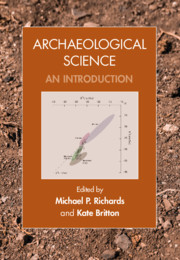Book contents
- Archaeological Science
- Archaeological Science
- Copyright page
- Contents
- Figures
- Tables
- Contributors
- Acknowledgements
- Part I Introduction
- Part II Biomolecular Archaeology
- 2 Ancient DNA
- 3 Proteomics
- 4 Residue Analysis
- 5 Isotope Analysis for Mobility and Climate Studies
- 6 Isotope Analysis for Diet Studies
- Part III Bioarchaeology
- Part IV Environmental Archaeology
- Part V Materials Analysis
- Part VI Absolute Dating Methods
- Index
- References
6 - Isotope Analysis for Diet Studies
from Part II - Biomolecular Archaeology
Published online by Cambridge University Press: 19 December 2019
- Archaeological Science
- Archaeological Science
- Copyright page
- Contents
- Figures
- Tables
- Contributors
- Acknowledgements
- Part I Introduction
- Part II Biomolecular Archaeology
- 2 Ancient DNA
- 3 Proteomics
- 4 Residue Analysis
- 5 Isotope Analysis for Mobility and Climate Studies
- 6 Isotope Analysis for Diet Studies
- Part III Bioarchaeology
- Part IV Environmental Archaeology
- Part V Materials Analysis
- Part VI Absolute Dating Methods
- Index
- References
Summary
Bone collagen carbon and nitrogen isotope analysis is a powerful tool for providing direct measures of past human diets (Lee-Thorp 2008; Macarewicz and Sealy 2015). Since it was first applied to archaeological bone samples in the late 1970s and early 1980s it has grown into a well-established and now widely applied method (Britton 2017).
Information
- Type
- Chapter
- Information
- Archaeological ScienceAn Introduction, pp. 125 - 144Publisher: Cambridge University PressPrint publication year: 2020
References
Accessibility standard: Unknown
Why this information is here
This section outlines the accessibility features of this content - including support for screen readers, full keyboard navigation and high-contrast display options. This may not be relevant for you.Accessibility Information
- 22
- Cited by
